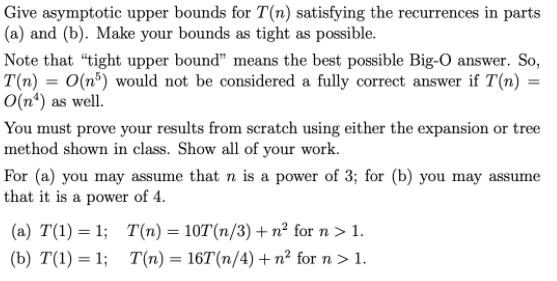Question
Give asymptotic upper bounds for T(n) satisfying the recurrences in parts (a) and (b). Make your bounds as tight as possible. Note that tight

Give asymptotic upper bounds for T(n) satisfying the recurrences in parts (a) and (b). Make your bounds as tight as possible. Note that "tight upper bound" means the best possible Big-O answer. So, T(n) = 0(n) would not be considered a fully correct answer if T(n) = O(n*) as well. You must prove your results from scratch using either the expansion or tree method shown in class. Show all of your work. For (a) you may assume that n is a power of 3; for (b) you may assume that it is a power of 4. (a) T(1) = 1; T(n) = 10T(n/3) + n? for n > 1. (b) T(1) = 1; T(n) = 16T(n/4) + n? for n > 1. %3D
Step by Step Solution
3.52 Rating (149 Votes )
There are 3 Steps involved in it
Step: 1
a Let n 4k Tn 6Tn Tn 66T n n 16 Tn 6T 6n n 16 Tn 66T 16...
Get Instant Access to Expert-Tailored Solutions
See step-by-step solutions with expert insights and AI powered tools for academic success
Step: 2

Step: 3

Ace Your Homework with AI
Get the answers you need in no time with our AI-driven, step-by-step assistance
Get StartedRecommended Textbook for
Intermediate Accounting
Authors: Donald E. Kieso, Jerry J. Weygandt, And Terry D. Warfield
13th Edition
9780470374948, 470423684, 470374942, 978-0470423684
Students also viewed these Accounting questions
Question
Answered: 1 week ago
Question
Answered: 1 week ago
Question
Answered: 1 week ago
Question
Answered: 1 week ago
Question
Answered: 1 week ago
Question
Answered: 1 week ago
Question
Answered: 1 week ago
Question
Answered: 1 week ago
Question
Answered: 1 week ago
Question
Answered: 1 week ago
Question
Answered: 1 week ago
Question
Answered: 1 week ago
Question
Answered: 1 week ago
Question
Answered: 1 week ago
Question
Answered: 1 week ago
Question
Answered: 1 week ago
Question
Answered: 1 week ago
Question
Answered: 1 week ago
Question
Answered: 1 week ago
Question
Answered: 1 week ago
Question
Answered: 1 week ago
Question
Answered: 1 week ago
Question
Answered: 1 week ago
Question
Answered: 1 week ago
View Answer in SolutionInn App



